Your Cart is Empty
spend R1000. 2kg or less. free shipping.
Menu

spend R1000. 2kg or less. free shipping.
bonsai
gardening
Orchids
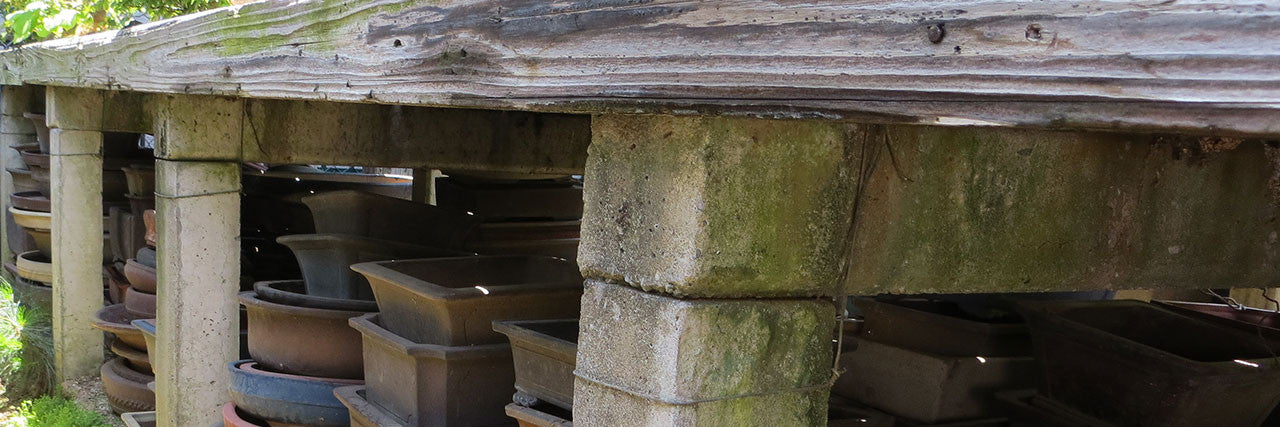
My Favourite Tokoname Potters
9 min read
Introduction
Tokoname, in case you don't know, is a small town in Aichi Prefecture in Japan. It is the home to ceramic kilns which produce many different kinds of quality ceramics. For us bonsai enthusiasts it is the source for bonsai pots to die for.
Unfortunately over the last number of years, several kilns have been forced to close for a variety of reasons not least of all due to the cheap pots flooding the market from other Eastern countries.
Although those kilns now stand empty and dormant the pots they once produced have become highly collectible today.
What is the allure?
I personally believe that if you appreciate fine bonsai you will have or will also develop equal appreciation for good containers. After all, the container is an integral part of bonsai. There is nothing quite like potting a mature tree into an old container which has developed patina from years of use and exposure to the elements.
Some enthusiasts actually become pot collectors and trees become an afterthought. I am not one of those people, and my limited budget does not permit me to keep many of such luxuries but I have had my fair share of debates with myself over the purchase of a pot which appealed greatly to me.
The following pots and their makers are of my favourites, not because they are especially valuable, as they aren't, but because I think they are exquisite.
1. Kouyou - Aiba
Aiba Kouichirou was born in 1944, into a family which produced ceramic containers for plants and also tableware. When he was in his 30's he built a new kiln and changed the name of the kiln to Koyo Toen. It was then that he began producing bonsai ceramics.
Aiba Koyo's glazed pots are very popular in Japan and internationally. Many Kokufu winning trees and countless magazines have featured trees potted in his containers on the front cover. My personal favourite glaze of his is called Oribe Yu.
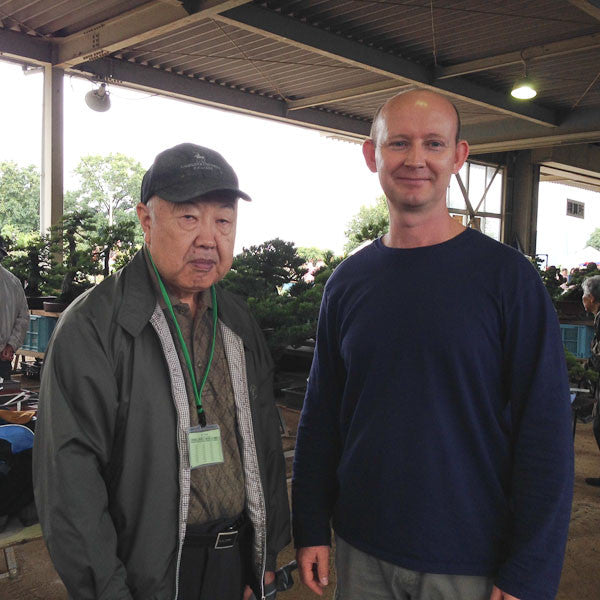
Image caption. I had the honour of meeting Aiba Kouichirou in 2014. He was walking around a market at a bonsai festival in Takamatsu where I recognized him and rather bashfully asked him to pose for a photo with me.
There are only two pots from this extraordinary gentleman in my collection, but I hope that in the future this might grow. There is a shohin yamadori olive I've been growing in a clump style for some years which I hope some day will be deserving of the drum in Oribe glaze.

Round drum, 160 x 50mm, Oribe glaze.
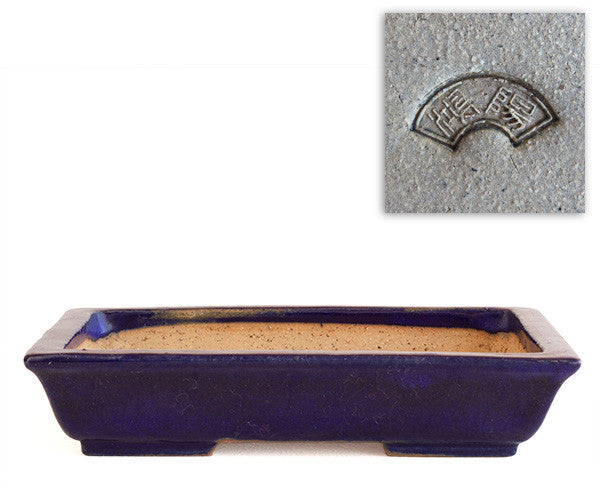
Rectangular container in deep blue glaze.
2. Yoshimura - Shuuhou
Situated literally within a stones throw from the famous Yamaaki kiln is the smaller kiln where pots under the trade name of Yoshimura are produced.
When I knew even less than I know now of Japanese potters I was already collecting, quite unbeknownst to me, pots from this kiln.
My favourites are the classic lines, glaze colours and shapes of the pots produced by Mr Susumi Kataoka. Below is one such example.
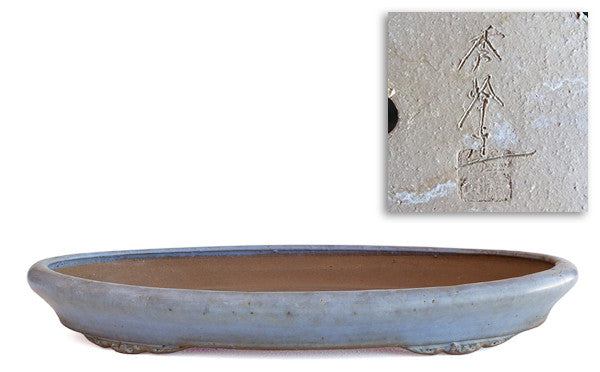
Shallow oval in baby blue colour glaze, 40 x 27 x 5cm
I love the colour which is so complimentary of any of the deciduous bonsai and also that the surface is not perfectly smooth but has a slight undulation to it which adds considerably to the character of the container. The added sign of age is the patina which has given this container a slight grey deposit at the rim and on other surfaces. The decorative feet add slight embellishment and add to the charm.
Aside from the container above I really fell in love with the following container in its sea green glaze. I believe it to be a more modern Japanese version of the Namako glaze which originates from China centuries ago.

Rectangular Shuuhou pot in Sea green Namako glaze, 33 x 25 x 7.5cm
The largest of my Shuuhou is this rectangular container in deep or navy blue. It will be the ideal container to exhibit one of my Hackberry in one day, when they have developed sufficiently to deserve to be elevated to such a status.
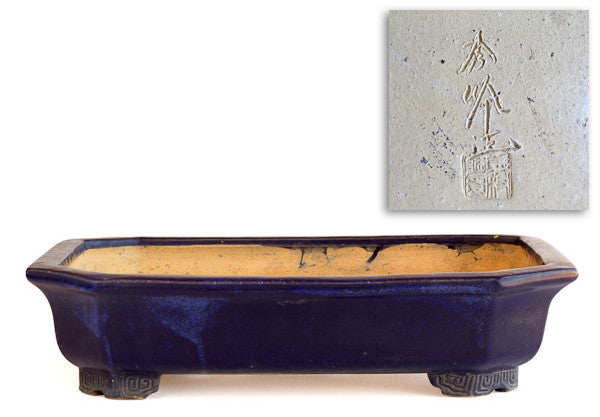
Dark navy blue Shuuhou rectangular container, 45 x 33 x 11cm
The kiln and name now belongs to the son, Mr Hidemi Kataoka. I had not met him before being introduced by Yukiko Kasai, when we went there on behalf of the local TV station. He is a most friendly gentleman who welcomed us into his place of work and showed us around.

Hidemi at ease in his workshop. Photo courtesy of Yukiko Kasai.
The workshop is not very large and the actual kiln is even smaller. It was such an experience to walk around in the loft scattered with yet unfinished pots. Some of which were of his latest design. I felt very privileged.

I don't have many of Hidemi's containers, only two in fact, but his glazes and design of his containers are very innovative. They have become very popular internationally very much due to the efforts of Yukiko Kasai who travels to many of the leading international bonsai exhibitions in Europe and other parts of the world both to promote and sell them. When Yukiko accompanied the Japanese delegation a few years ago to the Africa Bonsai Convention held in Stellenbosch, she had a small area at my vending stand where she sold many of his pots to very excited local bonsai enthusiasts.

A small hexagon bonsai pot of mine in Hidemi's version of Namako glaze, 11 x 7cm.
If you would like to order pots such as this or from many other Tokoname potters please do support Yukiko's website
3. Yamaaki - Koshousen
The Yamaaki kiln in Tokoname is world famous. During the time that this kiln was active it produced an incredible number of pots, all of very good quality. The stamps and signatures used by the artists are actually so recognizable now that when looking through an assortment of pots its actually easy to identify these containers, unlike some of the other lesser known or older containers.
To the best of my knowledge, this kiln has now closed down. Perhaps it would be more accurate to say that it has gone dormant as the structure and all is still there, or at least it was when I was last there in 2016. It is a very sad reality, and as a result of price wars between China and Japan.

Chimney of the Yamaaki kiln in Tokoname, Japan.
I have many Yamaaki containers, of course as they are generally rather plentiful and affordable. However the one pot which I like most is this one which I purchased from a colleague of my teacher, Mr. Junichiro Tanaka. I count myself very fortunate to be the proud owner of this container as they are not very easy to come by.
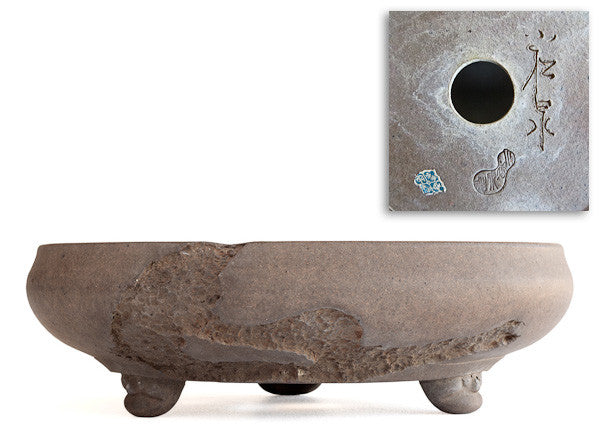
Yamaaki, 2nd generation bonsai pot (Mr. Sadamitsu Kataoka) with 'mishikui,' 29 x 9cm.
These containers have a unique relief carving on them which is hand done. I have seen these containers in various traditional shapes, this one is round though. In trying to read up about these containers all I can find out for the moment is that the technique is called "worm eaten" or in Japanese it is known as "mushikui." It is meant to look like something has eaten away the clay, very unusual and very interesting to me. Here is a view from the bottom of the container so you can see this technique has been applied at several points around the container.
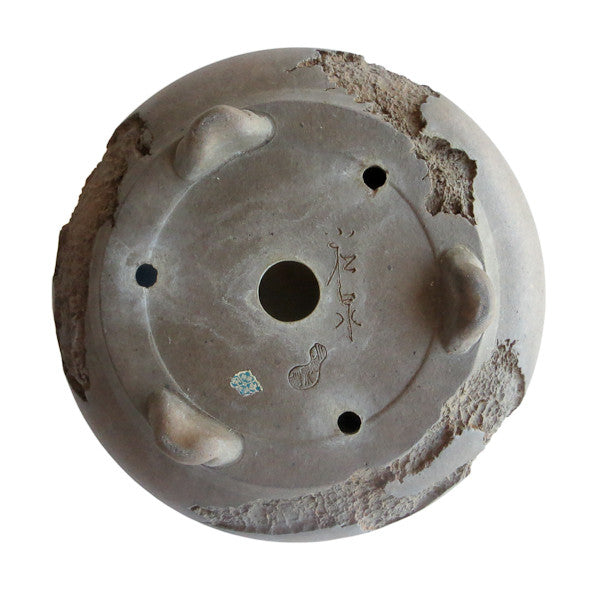
Sadamitsu Kataoka is a second generation potter who uses the trade name of Koshousen. He is the son of Akiji Kataoka who began the Yamaaki kiln, and who he also apprenticed for. Koshousen invented the technique or style of bonsai pot which I showed you above. He is also known for the following pot which has what is called a "wood grain" surface finish. What's particularly interesting about this pot for me is that it is the only one which I have seen where Koshousen has signed the pot in this manner.
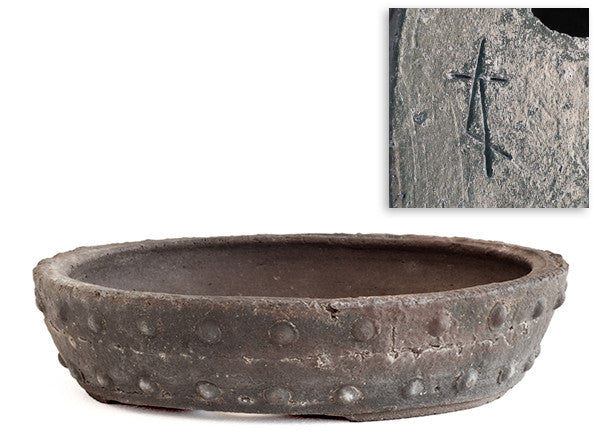
Wood grain finish round drum container made by 2nd generation Koshousen, 16.5 x 4cm
This next container is also by Koshousen and what I love about it is the incredible workmanship. The pot is perfectly proportioned, the surface finish immaculate. Its the type of pot which you can simply gaze at and appreciate for the immense skill it must require to produce such perfection.

Rectangular unglazed Yamaaki container by Koshousen, 39 x 28 x 8.5cm
4. Yamafusa
What I really enjoy and appreciate the pots made at the Yamafusa kiln is that they are extremely functional.
To my knowledge all the pots are made by Mr Koie Kazufusa but I have not been able to find much more information about him than that!
All the pots I have seen have all been glazed and as I have a number of deciduous trees these pots with beautiful, clean and classical lines with soft glazes are very functional. They can be combined with pretty much any deciduous tree to great effect.
I have several pots from this kiln and will just show a couple of my favourites. This blue rectangular pot has developed some wonderful patina over time. The pot does not appear that used however so I am not sure if it simply stood somewhere for a very long time. I can just imagine how great a nicely ramified Hackberry or Trident would look in this!

A decorative rectangular pot in blue glaze (kin) with great patina, 43 x 31 x 7cm.
This next pot is perhaps a little more difficult to put to use than the previous blue one but if you have a developed flowering or fruiting tree then with this yellow glazed container you have a winner. Once again it has developed a really pleasant patina and the glaze has such a wonderful depth to it, no reflective glassy finish, just smooth like satin.

Rectangular Yamafusa with band in yellow glaze, 35 x 26 x 6cm
If you are partial to Shohin sized bonsai then you are going to appreciate this next container. A couple years ago I actually bought a very nice Chinese maple bonsai in Omiya which was potted in this container. I have since then put it into a slightly larger container but the glaze colour and oval shape was perfectly suited to the Maple.
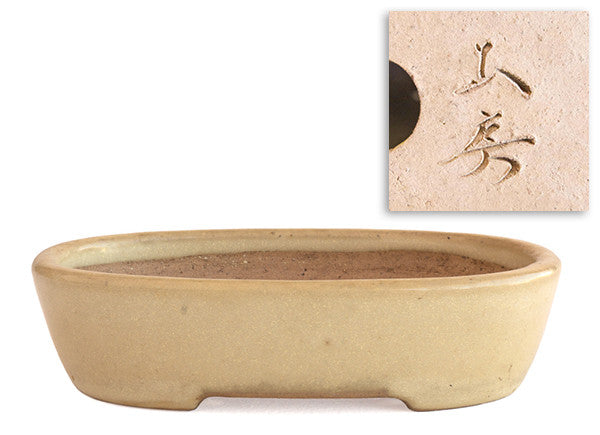
Shohin sized Yamafusa oval container in cream (shiro) glaze, 13.5 x 11 x 3cm
5. Reihou - Katoaka Katsuishi
It is difficult for me to tell Yamafusa and Reihou pots apart as they have very similar shapes and use glazes which are very much alike. Both of these potters though present very good value for money as their products are high quality and as they are fairly easy to come by, the prices are rather affordable. As a result I have a number of these pots as they are so suited to deciduous trees in general.
I'd say that this blue, rectangular pot made by Katoaka Katsuishi is my favourite of those that I currently have. This is as the blue has dulled over the years and patina has begun to form. I really like the shape and the proportions as it will lend itself to being used for a stocky deciduous tree. The bamboo motif which runs around the container adds a little charm, albeit very subtle so it does not detract from the pot as a whole.

Rounded rectangular bonsai pot in kin (pale blue) glaze with bamboo motif, 35 x 25 x 8.5cm.
This newer oval in Shiro glaze is another of my favourites from this kiln. You simply cannot go wrong with this colour as any deciduous or evergreen will look great in it. So even if you only have this one pot you can change the tree which is potted into it as you need to in preparation for an exhibition.
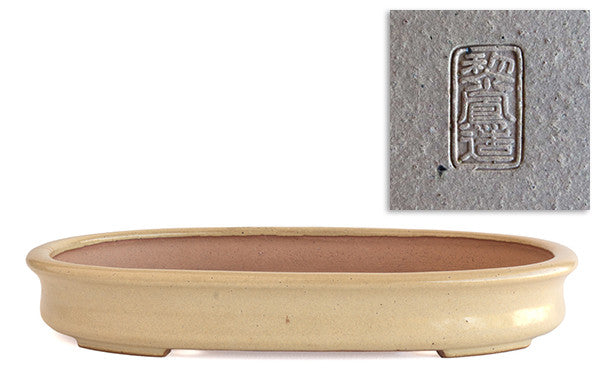
Oval in Shiro glaze made by Katoaka Katsuishi, 37.5 x 29.5 x 5.5cm.
6. Youzan - Eimei
What I appreciate very much about the containers produced at this kiln is the incredible precision of the workmanship. The containers are so precise. The colours can be bold and the shapes are very functional also. They are also not expensive as far as quality Tokoname pots go.
They glaze takes on patina very well to as you can see from this shallow oval container which was one yellow.

Yellow oval container from Eimei, 23.5 x 18 x 3cm
One of my favourites from Mr. Masakazu Shimizu is this small octagonal container in a green. I think it would look amazing with a shohin wild olive in it, don't you. None of that high gloss glaze that is so typical of cheaper Chinese ceramics.
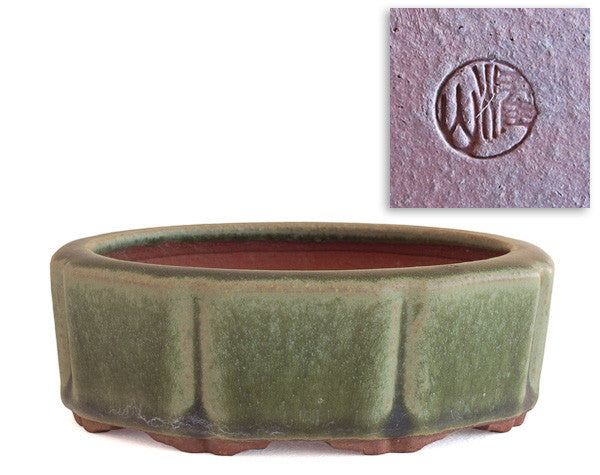
Green octagonal pot from Eimei, 13 x 4cm
Conclusion
Well I hope you have enjoyed reading this post and looking at the pictures of these beautiful containers, each one really a work of art in my humble opinion. I think it is high time in South Africa that more emphasis be placed on the container used by enthusiasts to display their trees in. It's my opinion that it is very often a bit of an after thought and certainly not something which many people will go to much expense for. The truth of the matter is that bonsai is not only the tree and that the container is an integral component which must be carefully considered and combining your tree with the right container will do much to enhance the overall impression.
The purpose of this article was to make you aware of some of the ceramics available out there, as many of these containers are available for sale on my site but also elsewhere on the web, and perhaps more specifically to focus a little on container appreciation.
Want to know when future newsletters are published, click here to subscribe. Don't want to receive mail in the future simply unsubscribe.
2 Responses
Janine
May 23, 2017
Hallo Terry, a very interesting article, loved that you added the stamp, so that someday, when I might lay my hands on a pot, at least I will know what Im dealing with. Pity I didt have time to visit these places when I was there in April :-(
Leave a comment
Comments will be approved before showing up.
Recent Articles
- Enthusiasts Top Wiring Tips July 17, 2023
- Top fertilizing tips March 28, 2023
- Top watering tips February 13, 2023
- Creating Japanese Maple forests October 24, 2022
- How to dig bonsai material August 15, 2022
- How I style bonsai and you can too April 30, 2022
- Swamp Cypress Bonsai Styling July 03, 2021
- How to hide large scars quickly June 14, 2021
- 14 Tips for Field Growing Bonsai May 31, 2021
- Aquaria: An Introduction January 06, 2021

FREE SAMPLE GIVEAWAY!
We are giving away samples of our new product, SuperBoost fertilizer pellets.
A unique organic blend of Blood meal, Bone meal, Canola meal, Fish meal, Fish hydrolysate. Macro, micro and trace minerals. Plant natural stimulating hormones, enzymes and amino acids.





Glenn Jensen
September 02, 2017
Excellent description of Tokoname potters and their work. Bonsai is my first love and I was fortunate to visit Tokoname and buy pots in 1984 with Harry Hirao and again in 1994. I treasure the bonsai pots for my trees and memories.
Thanks for your work.